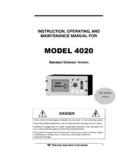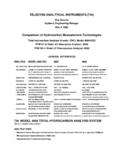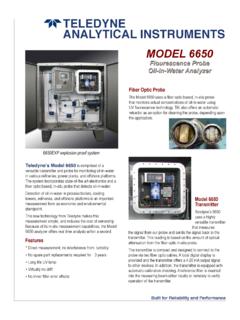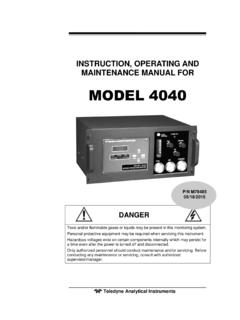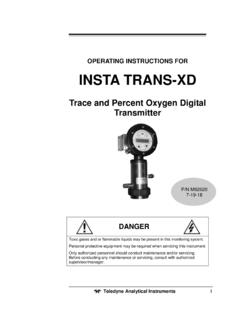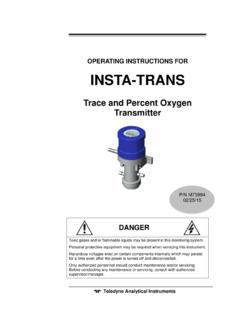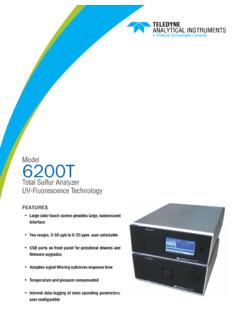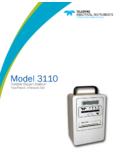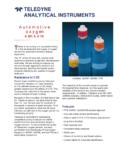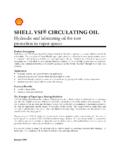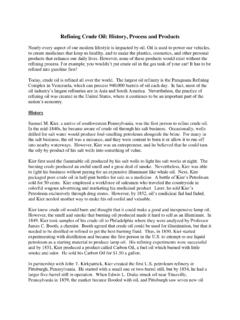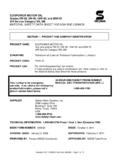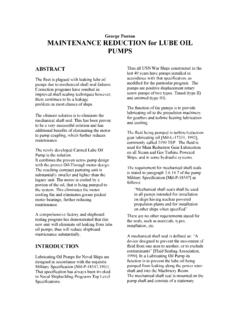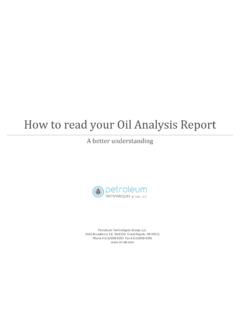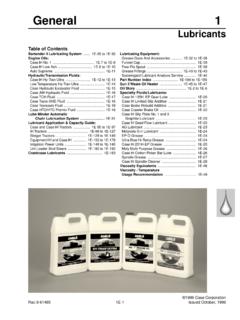Transcription of DOW CORNING CORPORATION Material Safety Data Sheet
1 DOW CORNING CORPORATION Material Safety data Sheet Page: 1 of 7 DOW CORNING 200(R) FLUID, 1000 CST. 1. IDENTIFICATION OF THE SUBSTANCE AND OF THE COMPANY Dow CORNING CORPORATION South Saginaw Road Midland, Michigan 48686 24 Hour Emergency Telephone: Customer Service: Product Disposal Information: CHEMTREC: (989) 496-5900 (989) 496-6000 (989) 496-6315 (800) 424-9300 MSDS No.: 01013246 Revision Date: 2002/12/09 Generic Description: Silicone Physical Form: Liquid Color: Colorless Odor: Characteristic odor NFPA Profile: Health 0 Flammability 1 Instability/Reactivity 0 Note: NFPA = National Fire Protection Association 2. OSHA HAZARDOUS COMPONENTS None present. This is not a hazardous Material as defined in the OSHA Hazard Communication Standard. 3. EFFECTS OF OVEREXPOSURE Acute Effects Eye: Direct contact may cause temporary redness and discomfort.
2 Skin: No significant irritation expected from a single short-term exposure. Inhalation: No significant effects expected from a single short-term exposure. Oral: Low ingestion hazard in normal use. Prolonged/Repeated Exposure Effects Skin: No known applicable information. Inhalation: No known applicable information. Oral: No known applicable information. Signs and Symptoms of Overexposure No known applicable information. Medical Conditions Aggravated by Exposure No known applicable information. The above listed potential effects of overexposure are based on actual data , results of studies performed upon similar compositions, component data and/or expert review of the product. Please refer to Section 11 for the detailed toxicology information. DOW CORNING CORPORATION Material Safety data Sheet Page: 2 of 7 DOW CORNING 200(R) FLUID, 1000 CST.
3 4. FIRST AID MEASURES Eye: Immediately flush with water. Skin: No first aid should be needed. Inhalation: No first aid should be needed. Oral: No first aid should be needed. Comments: Treat symptomatically. 5. FIRE FIGHTING MEASURES Flash Point: > 214 F / > C (Closed Cup) Autoignition Temperature: Not determined. Flammability Limits in Air: Not determined. Extinguishing Media: Carbon dioxide (CO2). Water spray. Dry chemical. Foam. Water can be used to cool fire exposed containers. Fire Fighting Measures: Self-contained breathing apparatus and protective clothing should be worn in fighting large fires involving chemicals. Unusual Fire Hazards: None. Hazardous Decomposition Products Thermal breakdown of this product during fire or very high heat conditions may evolve the following hazardous decomposition products: Carbon oxides and traces of incompletely burned carbon compounds.
4 Silicon dioxide. Formaldehyde. 6. ACCIDENTAL RELEASE MEASURES Containment/Clean up: Sections 13 and 15 of this MSDS provide information regarding certain federal and state requirements. Clean up remaining materials from spill with suitable absorbant. For large spills, provide diking or other appropriate containment to keep Material from spreading. If diked Material can be pumped, store recovered Material in appropriate container. Clean area as appropriate since some silicone materials, even in small quantities, may present a slip hazard. Final cleaning may require use of steam, solvents or detergents. Observe all personal protection equipment recommendations described in Sections 5 and 8. Local, state and federal laws and regulations may apply to releases and disposal of this Material , as well as those materials and items employed in the cleanup of releases.
5 You will need to determine which federal, state and local laws and regulations are applicable. Note: See section 8 for Personal Protective Equipment for Spills. Call Dow CORNING CORPORATION , (989) 496-5900, if additional information is required. 7. HANDLING AND STORAGE DOW CORNING CORPORATION Material Safety data Sheet Page: 3 of 7 DOW CORNING 200(R) FLUID, 1000 CST. Use with adequate ventilation. Avoid eye contact. Use reasonable care and store away from oxidizing materials. 8. EXPOSURE CONTROLS / PERSONAL PROTECTION Component Exposure Limits There are no components with workplace exposure limits. Engineering Controls Local Ventilation: None should be needed. General Ventilation: Recommended. Personal Protective Equipment for Routine Handling Eyes: Use proper protection - Safety glasses as a minimum. Skin: Washing at mealtime and end of shift is adequate.
6 Suitable Gloves: No special protection needed. Inhalation: No respiratory protection should be needed. Suitable Respirator: None should be needed. Personal Protective Equipment for Spills Eyes: Use proper protection - Safety glasses as a minimum. Skin: Washing at mealtime and end of shift is adequate. Inhalation/Suitable Respirator: No respiratory protection should be needed. Precautionary Measures: Avoid eye contact. Use reasonable care. Comments: When heated to temperatures above 150 degrees C in the presence of air, product can form formaldehyde vapors. Formaldehyde is a potential cancer hazard, a known skin and respiratory sensitizer, and an irritant to the eyes, nose, throat, skin, and digestive system. Safe handling conditions may be maintained by keeping vapor concentrations within the OSHA Permissible Exposure Limit for formaldehyde.
7 Note: These precautions are for room temperature handling. Use at elevated temperature or aerosol/spray applications may require added precautions. For further information regarding aerosol inhalation toxicity, please refer to the guidance document regarding the use of silicone-based materials in aerosol applications that has been developed by the silicone industry ( ) or contact the Dow CORNING customer service group. 9. PHYSICAL AND CHEMICAL PROPERTIES Physical Form: Liquid DOW CORNING CORPORATION Material Safety data Sheet Page: 4 of 7 DOW CORNING 200(R) FLUID, 1000 CST. Color: Colorless Odor: Characteristic odor Specific Gravity @ 25 C: Viscosity: 1000 cSt Freezing/Melting Point: Not determined. Boiling Point: > 65 C Vapor Pressure @ 25 C: Not determined. Vapor Density: Not determined. Solubility in Water: Not determined.
8 PH: Not determined. Volatile Content: Not determined. Note: The above information is not intended for use in preparing product specifications. Contact Dow CORNING before writing specifications. 10. STABILITY AND REACTIVITY Chemical Stability: Stable. Hazardous Polymerization: Hazardous polymerization will not occur. Conditions to Avoid: None. Materials to Avoid: Oxidizing Material can cause a reaction. 11. TOXICOLOGICAL INFORMATION Component Toxicology Information No known applicable information. Special Hazard Information on Components No known applicable information. 12. ECOLOGICAL INFORMATION Environmental Fate and Distribution Air: This product is a high molecular weight liquid polymer which has a very low vapour pressure (<1 mm Hg). As a result it is unlikely to become an atmospheric contaminant unless generated as an aerosol.
9 Water: This product has a very low water solubility (< 100 ppb). As it has a specific gravity of < 1, if discharged to water, it will initially form a surface film. As the product is non volatile and has a high binding affinity for particulate matter, it will adsorb to particulates and sediment out. DOW CORNING CORPORATION Material Safety data Sheet Page: 5 of 7 DOW CORNING 200(R) FLUID, 1000 CST. Soil: If discharged to surface water, this product will bind to sediment. If discharged in effluent to a waste water treatment plant, the product is removed from the aqueous phase by binding to sewage sludge. If the sewage sludge is subsequently spread on soil, the silicone product is expected to degrade. Degradation: This product, polydimethylsiloxane, degrades in soil abiotically to form smaller molecules. These in turn are either biodegraded in soil or volatilized into the air where they are broken down in the presence of sunlight.
10 Under appropriate conditions, the ultimate degradation products are inorganic silica, carbon dioxide and water vapour. Due to the very low water solubility of this product, standard OECD protocols for ready and inherent biodegradability are not suitable for measuring the biodegradability of this product. The product is removed >80% during the sewage treatment process. Environmental Effects Toxicity to Water Organisms: Based on analogy to similar materials this product is expected to exhibit low toxicity to aquatic organisms. Toxicity to Soil Organisms: Experiments show that when sewage sludge containing polydimethylsiloxane is added to soil, it has no effect on soil micro-organisms, earthworms or subsequent crops grown in the soil. Bioaccumulation: This product is a liquid and is a high molecular weight polymer. Due to its physical size it is unable to pass through, or be absorbed by biological membranes.
